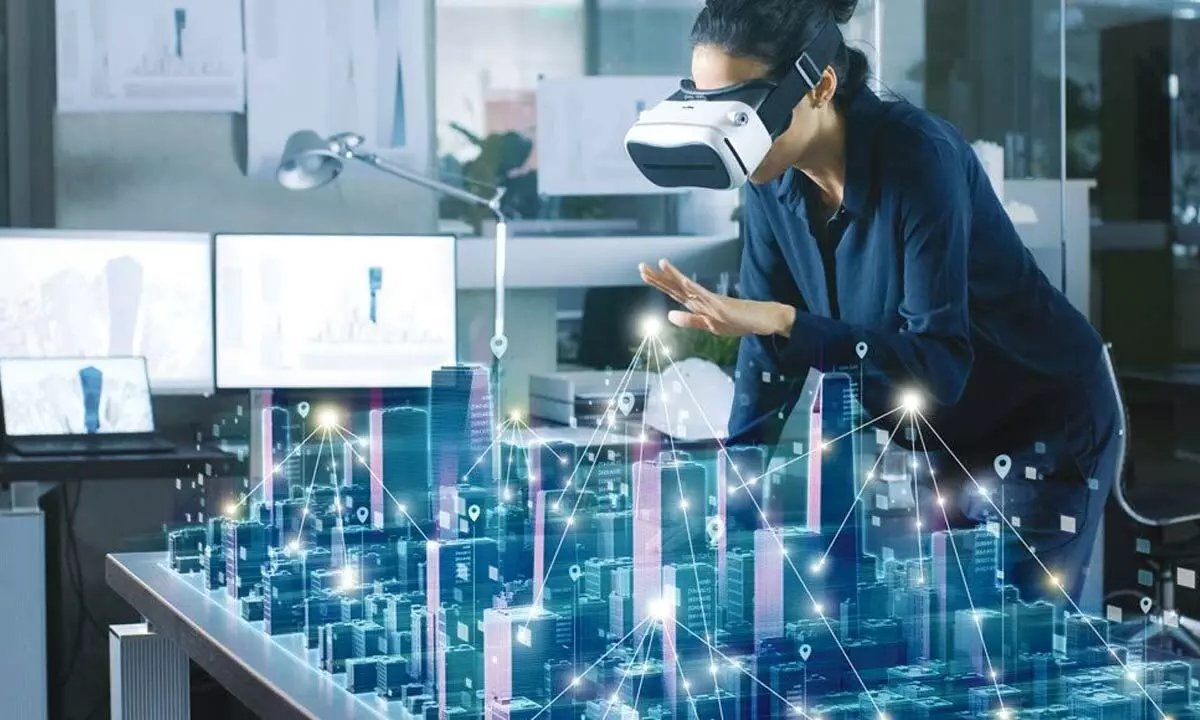Live
- Advocates Protest Misleading Land Allocation for Jogulamba Gadwal District Court Complex
- Good Swimmer, Lifejacket On’: Brother of Missing Man Holds Hope After Mumbai Boat Accident
- TTD Invites Proposals for 'Tirumala Vision-2047' Development Plan
- Champions Trophy 2025 Venue Revealed: India, BCCI Face Setback After ICC 'Compromise' Decision
- Apple vs. Meta: Privacy vs. Interoperability Under the EU’s Digital Markets Act
- District Collector Urges Swift Completion of Pending Construction Projects
- KTR Faces Case Over Rs 45-Crore Payment for Formula E Race in Hyderabad
- HYDRAA Demolishes Illegal Shops in Manikonda’s Alkapur Colony Amid Protests
- Why Dates Are a Winter Superfood: Top Health Benefits of Khajoor
- District Judge Ganta Kavitha Devi Conducts Surprise Inspection at Gadwal Government School
Just In
The transformative power of AR, VR in architectural design


The architectural landscape is undergoing a profound transformation thanks to the integration of Augmented Reality (AR) and Virtual Reality (VR) technologies.
The architectural landscape is undergoing a profound transformation thanks to the integration of Augmented Reality (AR) and Virtual Reality (VR) technologies. These tools, which have reshaped industries from gaming to healthcare, are now becoming essential in architectural design, revolutionizing how architects visualize, design, and present their work. As the demand for more immersive, efficient, and collaborative design processes grows, AR and VR are driving innovations that enhance both the creative and practical aspects of architecture.
AR and VR provide architects with a dynamic medium to explore their designs in ways that were previously impossible. Gone are the days of relying solely on 2D plans and models to communicate ideas. With VR, architects can now create fully immersive, 3D environments where clients can walk through a virtual representation of a building before it’s even constructed. This ability to experience spaces at full scale allows for more informed decision-making, as clients can visualize the proportions, materials, and functionality of a space. Recent trends show that this not only accelerates the approval process but also reduces costly design revisions down the line.
AR, on the other hand, blends the digital and physical worlds, providing architects with a tool to overlay virtual elements onto real-world environments. By using AR, architects can project 3D models of buildings onto construction sites or existing structures, giving stakeholders a clear understanding of how the design fits within its context. This is especially beneficial for urban projects, where integrating a new building into an existing landscape is crucial. The ability to see the potential impact of a design in its real-world location helps mitigate unforeseen challenges, improving the overall design quality and client satisfaction.
A notable trend in architectural design is the rise of collaborative workflows, enabled by AR and VR technologies. These tools allow multiple stakeholders, including architects, engineers, contractors, and clients, to work together in real-time on the same virtual model. VR platforms like Autodesk’s Revit Live and Enscape have become essential for collaborative design reviews, ensuring that everyone involved in the project is on the same page. In addition, VR can be integrated with Building Information Modeling (BIM), making it easier to track progress, address issues, and ensure that the design adheres to engineering constraints and local regulations. This streamlined collaboration not only enhances communication but also boosts efficiency, saving time and resources throughout the project lifecycle.
Sustainability is another area where AR and VR are making an impact. As the architecture industry shifts towards eco-friendly practices, these technologies are helping architects design with sustainability in mind. By simulating environmental conditions such as lighting, temperature, and wind flow, VR allows architects to assess the energy efficiency of a building before construction begins. AR also supports sustainability by offering tools to visualize how green building materials and renewable energy systems can be integrated into designs. This proactive approach helps architects minimize the environmental impact of their projects while meeting the growing demand for sustainable architecture.
The future of architectural design is undeniably tied to the continued development of AR and VR technologies. As these tools become more accessible and sophisticated, architects will be able to push the boundaries of creativity and functionality, delivering designs that are not only visually stunning but also highly efficient and sustainable. The recent adoption of these technologies in major projects worldwide underscores their transformative potential.
In conclusion, AR and VR are no longer just futuristic concepts—they are now integral to the architectural design process. By enhancing visualization, fostering collaboration, and supporting sustainability, these technologies are reshaping the way architects approach their work. As AR and VR continue to evolve, they will undoubtedly drive further innovation, leading to a more immersive, efficient, and sustainable future for architecture.
(The author is Principal, VES College of Architecture)

© 2024 Hyderabad Media House Limited/The Hans India. All rights reserved. Powered by hocalwire.com






